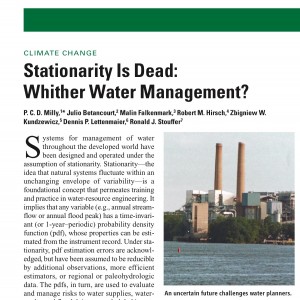We have a mismatch between 20th century plumbing and a 21st century climate.
USGS hydrologist Paul Milly and colleagues in 2008 threw down a marker in a Science paper arguing that human interventions (intentional and not) have rendered a basic premise of human water operations invalid. The premise is “stationarity”, the idea that with data from a sufficient long stretch of time, we can understand the range of variability to be expected from, say, the runoff in a mountain stream – the boundaries of wet and dry years, warm and cold ones (the jargon here is a “probability density function”, or “pdf”):
Under stationarity, pdf estimation errors are acknowledged, but have been assumed to be reducible by additional observations, more efficient estimators, or regional or paleohydrologic data. The pdfs, in turn, are used to evaluate and manage risks to water supplies, waterworks, and floodplains; annual global investment in water infrastructure exceeds U.S.$500 billion.
But what if we move the baseline, and past is no longer prologue? Milly and colleagues argued that we have, that “Stationarity is Dead”. Brett Walton’s Circle of Blue story this week on the shift from rain to snow snow to rain in the Pacific Northwest as climate warms offers a great case study in the implications:
Without an adequate snowpack, operators must hold more water in reservoirs in the winter so that supplies are available for cities, farmers, and fish later in the year. But the move to fill reservoirs in the winter also increases the chance of flooding if a big storm arrives.


“… the shift from rain to snow in the Pacific Northwest …” should be the other way, no?
oops, yes, fixed, thanks
An interesting and unintentional convergence in your post, John. The stationarity paper is one that Paul Fleming of Seattle Public Utilities who I quote in my story likes to cite.
It’s certainly an eye-opening “winter” this year. Upper 50s this week in Seattle and 60 tomorrow.
Brett – I love hearing this. Suggests Milly et al has served achieved the elusive goal of reaching beyond the academy.